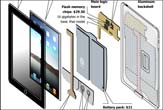iPad Breakdown: What's Inside and What it Costs to Make

A look deep into the electronic guts of Apple's new iPad has revealed that the basic version of the device costs about $260 to manufacture, according to the research firm iSuppli.
The company recently dissected the iPad in a so-called teardown analysis to find out just what makes Apple's much-heralded tablet computer tick. The teardown shows how the underlying structure of the iPad befits its purpose as a user-friendly, media-devouring device.
Accordingly, and as expected, much of the cost of building an iPad appears related to ensuring it is easy on the eye and simple and fun for people to operate. (Read more iPad news.)
The display, the multi-touch screen and other human-computer interface components make up nearly 44 percent of the total bill of materials for the basic 16 gigabyte (GB) memory, non-3G version of the iPad, according to iSuppli.
Dedicating this much of the manufacturing cost to the user's experience is a big departure from typical electronic product building, iSuppli said in a statement.
Personal elements including the display, keyboard and speakers on conventional notebook computers are built around the main computing components, such as the motherboard with its central processor and other circuits, and it is the latter that take up most of the costs.
Instead, "the iPad is user interface-centric rather than motherboard-centric," said Andrew Rassweiler, director and principal analyst and teardown services manager for iSuppli, an El Segundo, Calif.-based company.
Get the world’s most fascinating discoveries delivered straight to your inbox.
What you see and feel
The single most expensive part of an iPad is its 9.7-inch diagonal, thin film transistor liquid-crystal display that supports 262,000 colors and costs $65.
LG Display, a South Korean company, made the display in the particular model torn down by iSuppli, but the firm said that Apple might enlist other companies to make these displays down the road. The same goes for other parts and pieces of the iPad, and as Apple refines its manufacturing processes the costs and number of parts needed should decline, iSuppli said.
The next most expensive component, a glass touch screen and bezel assembly ballparked at $30, is made by Wintek, based in Taiwan.
Rounding out what one feels when holding an iPad is the aluminum backing that adds on $10.50.
Power of the computer chips
Unlike the smaller multi-touch screens for the iPhone and iPod Touch, which have a single silicon chip slotted for powering and processing the touch commands, the iPad sports three, said Rassweiler.
Irvine, Calif.-based semiconductor maker Broadcom made two of the chips that control the touch screen, which together tack on $3.70 to the iPad's base production cost. The other chip, crafted by Texas Instruments, comes in at $1.80.
At the heart of the iPad is its main processing chip, called an A4 and built by Samsung for $19.50. The chip was designed in-house by P.A. Semi, the computer chip company Apple acquired for just this reason back in 2008, said Rassweiler. An additional stacked memory chip by Samsung adds $7.30 to the cost of the layered processor.
A hodgepodge of other chips round out the iPad's features and bump production costs. A computer chip priced at $8.05 and also supplied by Broadcom enables Bluetooth and Wi-Fi wireless connections, and Austin, Texas' Cirrus Logic provides an audio chip costing $1.20. An additional $3.35 comes from power management chips from Dialog Semiconductor and Samsung.
All of the rest
Other key hardware items include the NAND-type flash memory, ranking as the third most-expensive component with a price tag of $29.50.
The fourth most expensive piece of hardware is the battery. The iPad's power is supplied by a dual-cell lithium polymer battery pack that costs $21. The 3.75 volt battery cells come from Amperex Technology Limited and the battery case is courtesy of Dynapack.
Various other electronic and structural components add on several tens of dollars, according to iSuppli.
All told, 52 percent of the retail price of the lowest-priced $499 iPad is tied up in its hardware, including the $9 cost of actually building the thing along with box contents priced at $7.50 for a total of $259.60.
Advertising, distribution, patent licensing, research and development costs and more then come out of the other half of the retail sale price before Apple sees any profit.
"If you look at the whole supply chain from conception point to when [the iPad] arrives in your hand, there is so much beyond just those raw materials," Rassweiler told TechNewsDaily.
Rassweiler said that a comparison of devices "Apple-to-Apple," such as the iPhone to the iPad, previously studied by iSuppli indicates that the ratio of product cost to retail is about the same across the board.
As for an actual profit margin that Apple gets per iPad sold, iSuppli said it cannot say for sure.
For the mid- and high-level versions of the iPad with more memory, the margin would seem to be higher, however. The material cost is $289.10 for the middle-of-the-road 32GB iPad version that retails for $599, and the Cadillac 64GB version that sells for $699 costs about $348.10 to crank off the assembly line.
 Live Science Plus
Live Science Plus






